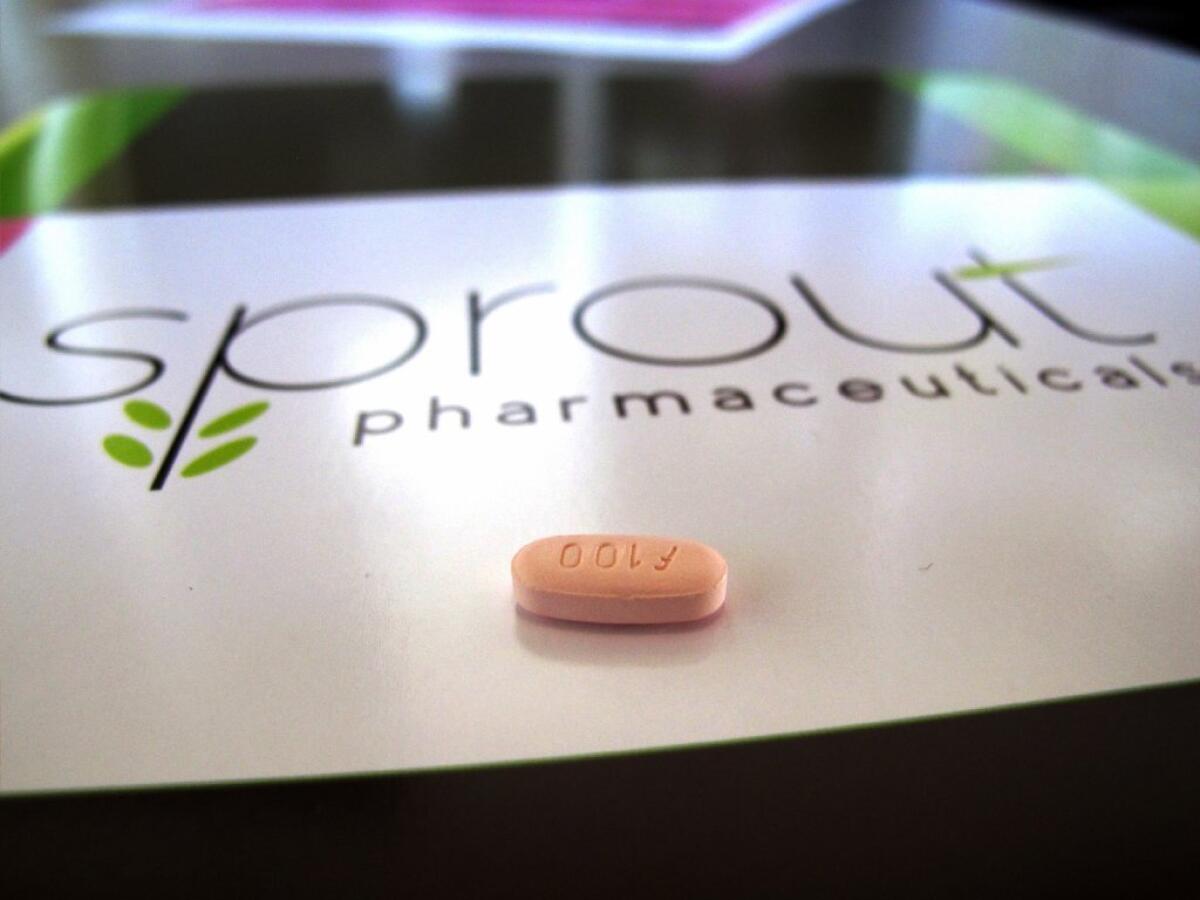Pink Viagra: Can’t get no satisfaction

The pill approved for low female sexual desire continues to spark passionate debate. A new study finds the new drug’s performance in piquing sexual interest in pre-menopausal women wanting.
- Share via
In the roughly six months since the Food & Drug Administration gave its blessing to the marketing of flibanserin, a prescription treatment for low libido in premenopausal women, the average patient taking the newly minted medication should have had three additional satisfying sexual events.
She also would be four times likelier than a woman not taking the drug to suffer dizziness, four times likelier to report excessive sleepiness, and more than twice as likely to feel nauseated, says new research.
Those findings, coming from a first pooled analysis of five published and three unpublished clinical trials, adjust downward the picture of modest effectiveness touted by the FDA at the time of flibanserin’s approval, when the drug was said to increase satisfying sexual encounters by closer to one a month.
NEWSLETTER: Get the day’s top headlines from Times Editor Davan Maharaj >>
The findings suggest, in the words of six European experts in female sexuality, that “the meaningful change caused by flibanserin is minimal.”
Meanwhile, researchers who conducted the analysis of trials assessing flibanserin concluded that it is “premature” to declare the medication safe. All told, the new analysis reflects the drug’s safety and effectiveness as tested in some 5,914 women.
Given that 90% of physicians have said they are keen to prescribe an FDA-approved drug for women complaining of flagging libido, the stakes are high, the study’s authors wrote Monday in the journal JAMA Internal Medicine.
Sprout Pharmaceuticals, the North Carolina-based that won approval for flibanserin, has volunteered that it would hold off launching radio or television advertisements for Addyi, as it calls the new drug, until roughly this time next year.
But before flibanserin should be recommended by clinical-guideline writers and prescribed by physicians eager to help women, wrote the new study’s authors, there’s work to be done: the medication needs to prove itself safe and effective for use by a far wider range of women than those in whom it has been tested, including women who take other medications for other health conditions and those who have been plunged early into menopause by surgery. Its likely use by post-menopausal women and by women who drink alcohol and take birth control medications also need to be better understood, they wrote.
“The flibanserin saga is unsatisfying,” wrote Dr. Steven Woloshin and Dr. Lisa M. Schwartz, professors at Dartmouth Medical School in a commentary published alongside the new analysis. Even after its own advisors had recommended rejection of Sprout’s third attempt at approval, they wrote, “the FDA approved a marginally effective drug for a non-life-threatening condition in the face of substantial -- and unnecessary -- uncertainty about its dangers.”
Sprout’s third bid for the FDA’s blessing had offered no new evidence of the drug’s effectiveness, Schwartz and Woloshin wrote. On the contrary, one new study suggested that one in nine who take the drug might have a genetic variation that could cause fainting after just one dose. But in bringing flibanserin before the FDA for a third time, Sprout did launch a public advocacy campaign, called “Even the Score,” that charged gender bias in the drug-safety agency’s deliberations on drugs to address male and female sexual dysfunction.
Last August, the FDA overruled its own clinical reviewers, who recommended a third rejection for flibanserin, and approved the drug.
“Women with distressing sexual desire problems need good treatments,” Schwartz and Woloshin wrote. But, they added, “we all need a drug approval process that delivers good decisions based on adequate evidence.”
See more of our top stories on Facebook >>
The new research -- and Schwartz and Woloshin’s commentary -- suggests that flibanserin’s fitful progress through the FDA’s approval process was driven by research that was light on detail, erected shifting goalposts, and was more likely to be published when the drug’s effectiveness was greater.
A study that set out to test whether flibanserin and alcohol could be safely mixed was conducted on men -- and even then, even a modest amount of alcohol led in many cases to dizziness and low blood pressure. Post-marketing studies required by the FDA at the time it approved flibanserin won’t be done for between a year and 2 1/2 years.
Follow me on Twitter @LATMelissaHealy and “like” Los Angeles Times Science & Health on Facebook.
MORE IN SCIENCE:
Are climate-change adaptations tied to protecting property or people? Study follows the money
Zika’s link to Guillain-Barre syndrome revealed
A view of the Milky Way like you’ve never seen before




